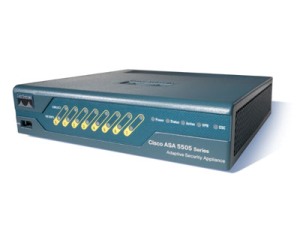The newest Cisco ASA firewall 5500 series came out with software version 7.0, following the successful software version 6.x of the older PIX firewall models. The latest ASA software version is 8.x with intermediary versions of 7.1 and 7.2. In this post I will show you how to upgrade a Cisco ASA 5505 firewall from version 7.2(3) to version 8.0(2). The same approach can be used for any 5500 appliance series. To get the latest ASA software version, you must have a valid SMARTnet agreement which is basically a maintenance contract for your Cisco product.

Step1:
Connect to the appliance (console or SSH) and verify the current running software version by using the show ver command:
ASA5505# sh ver
Cisco Adaptive Security Appliance Software Version 7.2(3)
Device Manager Version 5.2(3)
Compiled on Wed 15-Aug-07 16:08 by builders
System image file is “disk0:/asa723-k8.bin”
Config file at boot was “startup-config”
ASA5505 up 34 mins 42 secs
Hardware: ASA5505, 256 MB RAM, CPU Geode 500 MHz
Internal ATA Compact Flash, 128MB
BIOS Flash M50FW080 @ 0xffe00000, 1024KB
Encryption hardware device : Cisco ASA-5505 on-board accelerator (revision 0x0)
Boot microcode : CNlite-MC-Boot-Cisco-1.2
SSL/IKE microcode: CNlite-MC-IPSEC-Admin-3.03
IPSec microcode : CNlite-MC-IPSECm-MAIN-2.04
0: Int: Internal-Data0/0 : address is 001e.7a86.1ea8, irq 11
1: Ext: Ethernet0/0 : address is 001e.7a86.1ea0, irq 255
2: Ext: Ethernet0/1 : address is 001e.7a86.1ea1, irq 255
3: Ext: Ethernet0/2 : address is 001e.7a86.1ea2, irq 255
4: Ext: Ethernet0/3 : address is 001e.7a86.1ea3, irq 255
5: Ext: Ethernet0/4 : address is 001e.7a86.1ea4, irq 255
6: Ext: Ethernet0/5 : address is 001e.7a86.1ea5, irq 255
7: Ext: Ethernet0/6 : address is 001e.7a86.1ea6, irq 255
8: Ext: Ethernet0/7 : address is 001e.7a86.1ea7, irq 255
9: Int: Internal-Data0/1 : address is 0000.0003.0002, irq 255
10: Int: Not used : irq 255
11: Int: Not used : irq 255
Licensed features for this platform:
Maximum Physical Interfaces : 8
VLANs : 3, DMZ Restricted
Inside Hosts : 50
Failover : Disabled
VPN-DES : Enabled
VPN-3DES-AES : Enabled
VPN Peers : 10
WebVPN Peers : 2
Dual ISPs : Disabled
VLAN Trunk Ports : 0
This platform has a Base license.
From the above output you can see that we are running Version 7.2(3) which is located in disk0 (disk0:/asa723-k8.bin). Also, the GUI device manager version (ASDM) is 5.2(3). Now, lets upgrade to version 8.0(2).
Step 2:
Assume that our internal network range is 192.168.1.0/24. Configure a TFTP server (you can use the free tftpd32) on an internal PC (e.g 192.168.1.10) and backup the current running software image from the firewall to your TFTP PC.
ASA5505# copy disk0 tftp
Source filename []?asa723-k8.bin
Address or name of remote host []? 192.168.1.10
Also, save the current running configuration. Just issue the show run command and copy all configuration output from your terminal window into a text file.
Step 3:
Now it’s the time to upload the new software image file to the disk system of the firewall. Assume that we have already downloaded the software file asa802-k8.bin and placed that on our TFTP PC.
ASA5505# copy tftp disk0
Address or name of remote host []? 192.168.1.10
Source filename []? asa802-k8.bin
Destination filename [disk0]? disk0:asa802-k8.bin
Accessing tftp://192.168.1.10/asa802-k8.bin…!!!!!! (truncated)
Writing file disk0:/asa802-k8.bin… !!!!! (truncated)
14524416 bytes copied in 118.210 secs (123088 bytes/sec)
Step 4:
Since now we will have two image files on the firewall disk (old 7.2 and new 8.0 image files), we need to tell the firewall explicitly which image file to use when booting.
ASA5505# conf t
ASA5505(config)# boot system disk0:/asa802-k8.bin
ASA5505(config)# wr mem
Step 5:
Reboot the firewall in order to load the new software image file. (use the reload command). If everything works ok with the new image, you can delete the old one from disk0. (delete disk0:/asa723-k8.bin)
Step6 (Optional):
The new ASA version 8.x uses the newest Device Manager (ASDM) version 6.x. You can download the new ASDM software from Cisco and upgrade that as well (using the same steps as above).
Related Posts
- What is Cisco ASA Firewall – All you need to Know
- Traffic Rate and Bandwidth Limiting on Cisco ASA Firewall
- Cisco ASA Firewall (5500 and 5500-X) Security Levels Explained
- Cisco ASA 5505-5510-5520-5540-5550-5580 Performance Throughput and Specs
- Password Recovery for the Cisco ASA 5500 Firewall (5505,5510,5520 etc)